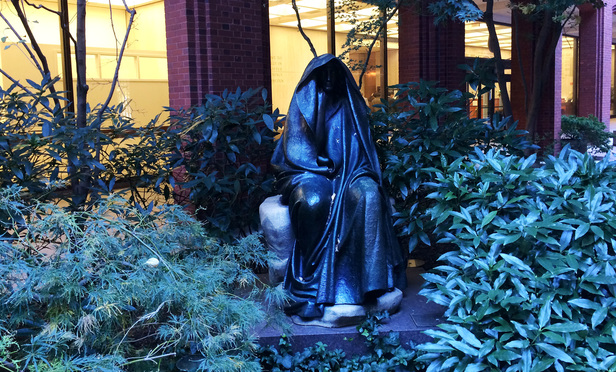It’s hard to think of anything less supernaturally spooky than patent infringement or takings claims, but the two federal courts charged with hearing such cases are among the most hauntedplaces in Washington–at least according to popular legend.
 The historic Lafayette Square buildings that house the U.S. Court of Appeals for the Federal Circuit and the U.S. Court of Federal Claims are associated with a pair of high-profile ghosts, not to mention a shrouded statue whose eyes are said to glow red at the stroke of midnight, and in whose lap you might see spirits of the dead.
The historic Lafayette Square buildings that house the U.S. Court of Appeals for the Federal Circuit and the U.S. Court of Federal Claims are associated with a pair of high-profile ghosts, not to mention a shrouded statue whose eyes are said to glow red at the stroke of midnight, and in whose lap you might see spirits of the dead.
“There are a lot of stories,” said Frank Harris, co -owner of DC Ghost Tours, which conducts year-round walking tours of Lafayette Square-otherwise known as “Tragedy Square”-a seven-acre park directly north of the White House.
On the eastern corner sits the Cutts-Madison House, a three-story yellow colonial that was home to First Lady Dolley Madison from 1837 until her death there in 1849. Over the years, Harris said, numerous people have reported “seeing her ghost sitting on the porch in a rocking chair, waving at the people as they pass by.”
The house is now part of the Federal Circuit, with an elegantly restored reception room on the ground floor and staff offices above.
Not to be a spoil-sport, but court librarian Patricia McDermott points out that the porch wasn’t actually part of the house during Dolley’s lifetime. No matter. “She was definitely a very social person,” McDermott said, laughing. Perhaps the ghost is just enjoying the addition?
McDermott said those who work at the courts complex are “certainly aware” of the historic ghost stories, which are often recounted to new law clerks.
“I know over the years, there has been talk of hearing sounds late at night,” she said. “It’s definitely a spooky place to be late at night by yourself.”
Another ghost-one with a particularly juicy legal pedigree-is that of Philip Barton Key II, son of Francis Scott Key and nephew of the fifth U.S. Supreme Court chief justice, Roger Taney. Key was the U.S. attorney for the District of Columbia when he was killed in Lafayette Square in 1859 by Congressman Daniel Sickles of New York. Key was having an affair with Sickles’ wife, Theresa.
Sickles shot Key in front of the Benjamin Ogle Tayloe House, also now part of the courts complex (the cafeteria is on the second floor.) Key’s ghost, looking at times like a dark shape or a real person, has been spotted multiple times in the park in front of the court, according to Harris.
At trial, Sickles pleaded not guilty by reason of temporary insanity and was acquitted-the first time the defense was used successfully in the United States.
In the late 1950s, the government made plans to raze the old Lafayette Square buildings and replace them with white, neoclassical structures to serve as courts and executive office buildings. At the urging of First Lady Jacqueline Kennedy, President John F. Kennedy intervened to save the historic buildings.
In 1967, the Court of Customs and Patent Appeals (the Federal Circuit’s predecessor) and the Court of Claims moved into the Lafayette Square complex, now known as the Howard T. Markey National Courts Building.
The structure combines the Cutts-Madison and Tayloe houses, along with the old Cosmos Club, joining them with a modern nine-story brick building.
The new complex needed artwork. The courtyard in front of the visitor’s entrance features an unexpected choice: “Black Aggie.”
In some ways, it’s appropriate: The sculpture is a copy of the one that marks Marian “Clover” Adams’ grave in Rock Creek Cemetery. Married to Hay-Adams Hotel cofounder Henry Adams (the grandson of President John Quincy Adams and great-grandson of President John Adams), Clover committed suicide by ingesting potassium cyanide in 1885 at her home on H Street bordering Lafayette Square. The luxury hotel was erected on the site-and some say her ghost haunts the fourth floor.
Henry Adams commissioned sculptor Augustus Saint-Gaudens and architect Stanford White to create Clover’s memorial, nicknamed “Grief” by its creator.
But the statue in front of the Federal Circuit-the court uniquely charged with interpreting the nation’s intellectual property laws-is an unauthorized copy.
The copycat statue was originally placed on the grave of General Felix Agnus in Pikesville, Md. in 1925. Over the years, it was often vandalized and the stories grew: Pregnant women who passed through Aggie’s shadow would miscarry, spirits of the dead gathered around her, a college fraternity initiate required to spend the night on her lap was crushed to death when she came to life.
In 1967, the Agnus family donated the work to the Smithsonian Institution, which passed it on to the General Services Administration when it was determined to be knockoff. McDermott of the Federal Circuit said the piece wound up at the court thanks to a push by a member of the old Cosmos Club, who deemed it an apt resting place for the artwork, given the Clover Adams/ Lafayette Square connection.
Lewis Wiener, president of the Court of Federal Claims Bar Association and a partner at Sutherland Asbill & Brennan, said the statue gave him a fright one dark and stormy evening.
“I was leaving the court late at night,” he said. It was pitch-black and pouring rain, he recalled, and one of the courtyard gates was unexpectedly locked. “A lightning bolt struck, highlighting the statue,” he said. “It scared the hell out of me.”
Still, Wiener said, when it comes to true terror at the court, nothing can rival pressing questions by a judge during oral argument. “But it’s a wonderful, historic building,” he said.
This content has been archived. It is available through our partners, LexisNexis® and Bloomberg Law.
To view this content, please continue to their sites.
Not a Lexis Subscriber?
Subscribe Now
Not a Bloomberg Law Subscriber?
Subscribe Now
LexisNexis® and Bloomberg Law are third party online distributors of the broad collection of current and archived versions of ALM's legal news publications. LexisNexis® and Bloomberg Law customers are able to access and use ALM's content, including content from the National Law Journal, The American Lawyer, Legaltech News, The New York Law Journal, and Corporate Counsel, as well as other sources of legal information.
For questions call 1-877-256-2472 or contact us at [email protected]



